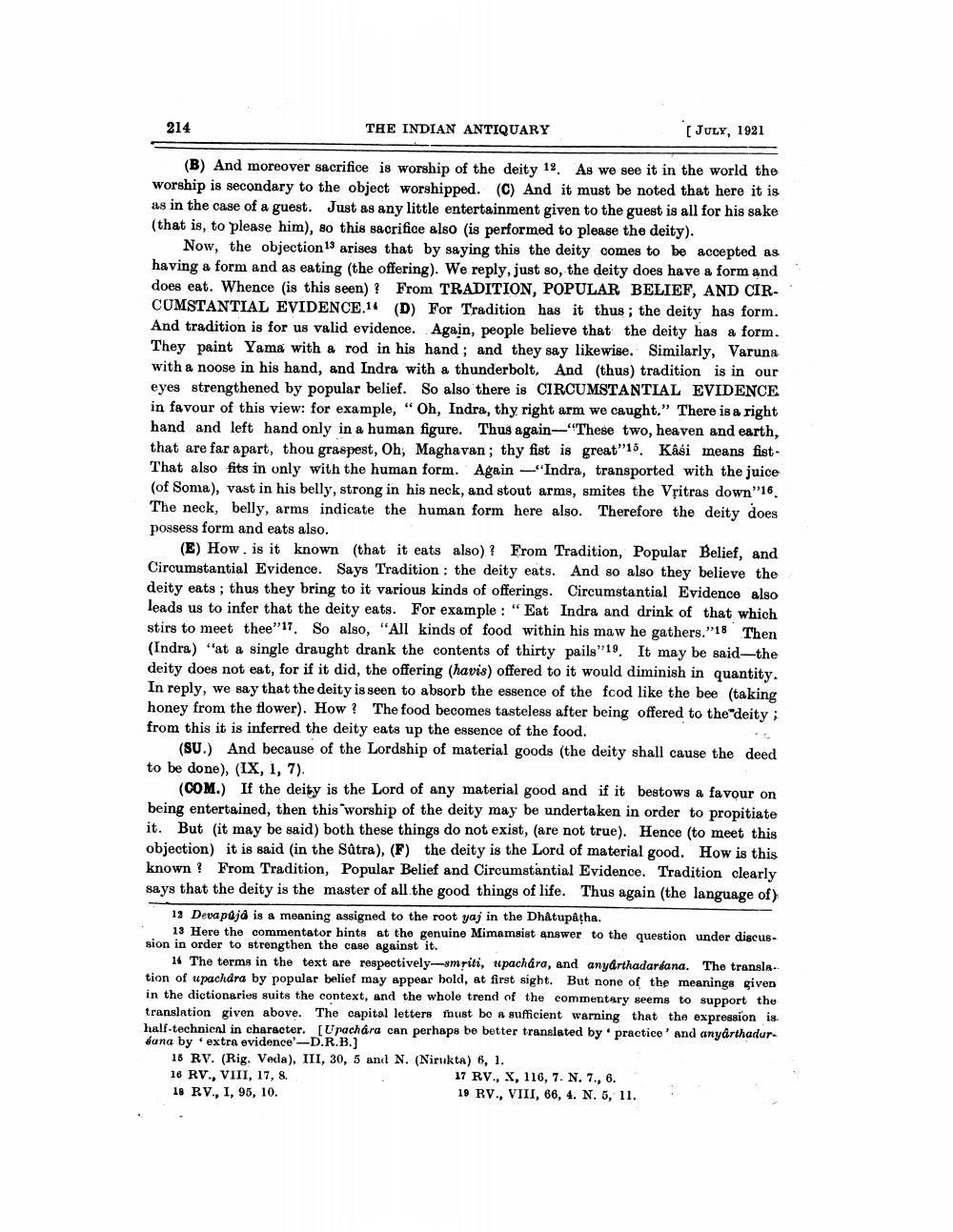________________
214
THE INDIAN ANTIQUARY
[July, 1921
(B) And moreover sacrifice is worship of the deity 18. As we see it in the world the worship is secondary to the object worshipped. (C) And it must be noted that here it is as in the case of a guest. Just as any little entertainment given to the guest is all for his sake (that is, to please him), so this sacrifice also is performed to please the deity).
Now, the objection 13 arises that by saying this the deity comes to be accepted as having a form and as eating (the offering). We reply, just so, the deity does have a form and does eat. Whence (is this seen)? From TRADITION, POPULAR BELIEF, AND CIRCUMSTANTIAL EVIDENCE.14 (D) For Tradition has it thus, the deity has form. And tradition is for us valid evidence. Again, people believe that the deity has a form They paint Yama with a rod in his hand; and they say likewise. Similarly, Varuna with a noose in his hand, and Indra with a thunderbolt, And (thus) tradition is in our eyes strengthened by popular belief. So also there is CIRCUMSTANTIAL EVIDENCE in favour of this view: for example, "Oh, Indra, thy right arm we caught." There is a right hand and left hand only in a human figure. Thus again—"These two, heaven and earth, that are far apart, thou graspest, Oh, Maghavan; thy fist is great”15. Kasi means fistThat also fits in only with the human form. Again - Indra, transported with the juice (of Soma), vast in his belly, strong in his neck, and stout arms, smites the Vritras down"16. The neck, belly, arms indicate the human form here also. Therefore the deity does possess form and eats also.
(E) How is it known (that it eats also)? From Tradition, Popular Belief, and Circumstantial Evidence. Says Tradition: the deity eats. And so also they believe the deity eats; thus they bring to it various kinds of offerings. Circumstantial Evidence also leads us to infer that the deity eats. For example: "Eat Indra and drink of that which stirs to meet thee'17. So also, "All kinds of food within his maw he gathers."18 Then (Indra) "at a single draught drank the contents of thirty pails" 19. It may be said the deity does not eat, for if it did, the offering (havis) offered to it would diminish in quantity. In reply, we say that the deity is seen to absorb the essence of the food like the bee (taking honey from the flower). How? The food becomes tasteless after being offered to the deity : from this it is inferred the deity eats up the essence of the food.
(SU.) And because of the Lordship of material goods (the deity shall cause the deed to be done), (IX, 1, 7).
(COM.) If the deity is the Lord of any material good and if it bestows a favour on being entertained, then this worship of the deity may be undertaken in order to propitiate it. But it may be said) both these things do not exist, (are not true). Hence (to meet this objection) it is said in the Sûtra), (F) the deity is the Lord of material good. How is this known? From Tradition, Popular Belief and Circumstantial Evidence. Tradition clearly says that the deity is the master of all the good things of life. Thus again (the language of)
13 Deva půjd is a meaning assigned to the root yaj in the Dhatupátha.
13 Here the commentator hints at the genuine Mimamsist answer to the question under discus. sion in order to strengthen the case against it.
1. The terms in the text are respectively-smriti, upachara, and anyarthadardana. The transla. tion of upachdra by popular belief may appear bold, at first sight. But none of the meanings given in the dictionaries suits the context, and the whole trend of the commentary seems to support the translation given above. The capital letters must be a sufficient warning that the expression is. half-technicnl in character. [Urachára can perhaps be better translated by practice and anyarthadur. bana by extra evidence'-D.R.B.)
16 RV. (Rig. Veda), III, 30, 5 and N. (Nirukta) 6, 1. 18 RV., VIII, 17, 8.
17 RV., X, 116, 7. N. 7., 6. 19 RV., I, 95, 10.
19 RV., VIII, 66, 4. N. 5, 11.




